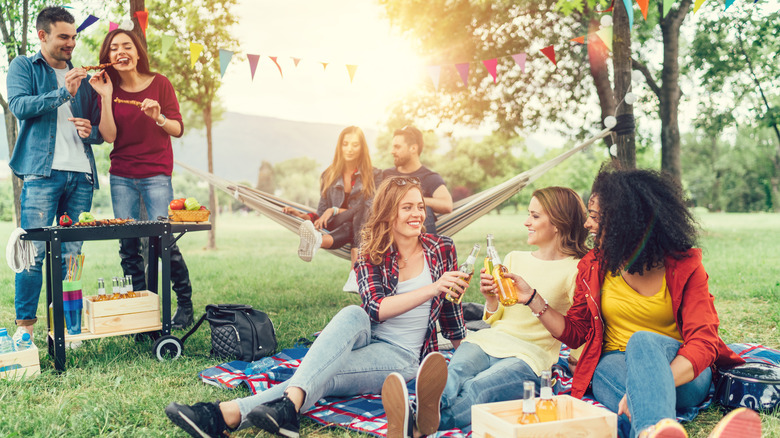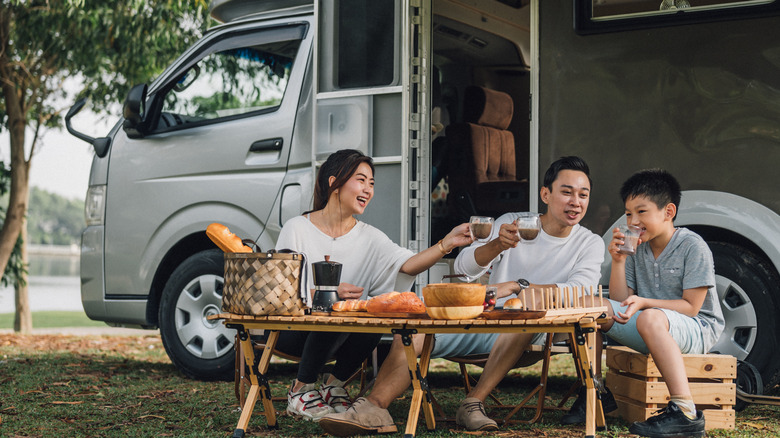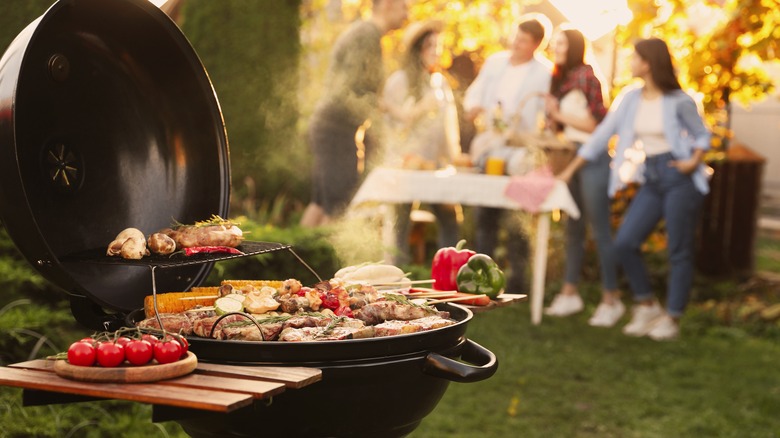How To Set Yourself Up For A Successful Public Cookout
Summertime is all about outdoor entertaining, and public parks are a great resource whether you're a city dweller or your backyard isn't large enough for your gathering. However, before you send out the invitations, there are a few things to consider beyond the menu and guest list when planning a public cookout, like how to keep food cold.
The first step is to determine the park rules. Check to see if the town charges a fee to rent the space or requires permits and reservations. Depending on the party you are throwing, ask if alcohol, loud music, and pets are allowed. If you promised a bounce house at the cookout, make sure you can have a generator or access to electricity and inquire how long you have the space to allot time for set up and cleanup.
Familiarize yourself with the park's facilities and inquire whether you can access everything you need, like running water, bathrooms, picnic tables, parking, a grill, garbage cans, and shade. If it's a sunny day, securing a pavilion or gazebo can save your guests from heat stroke and the party from cancelation if rain creeps into the forecast.
Things change or break, so don't rely on the park's website for information, as it may not be current or reflect scheduled maintenance. Some parks cap the number of people allowed, so please verify that your cookout falls within the limit.
Make a comprehensive list
Now that you know the rules, it's helpful to make a comprehensive list of everything you must bring to the park to avoid multiple trips. Think about your decorations, food, beverages, serving pieces, and entertainment. Organizing a potluck can be convenient for the host, just include that detail in your invitation and keep track of what everyone is bringing to ensure enough table space.
Consider your guests' comfort and whether you have enough seating for everyone needing it. If you expect guests to sit on the ground to picnic, provide waterproof mats or blankets if the grass is wet. Low tables are convenient for resting food and drinks, and oversized pillows can enhance a Boho theme and make the space more comfortable.
If your cookout is in the evening, check for overhead lighting and whether you need lanterns. Citronella candles can do double duty if the park allows them, especially if the menu attracts pests.
Think about how you plan to serve each dish at your cookout. While reusable plates and utensils from home are a sturdier, classier option, you may not want to haul dozens of dishes to and from the park, especially with an extensive guest list, so consider alternative eco-friendly options. Recyclable paper and bamboo plates, cups, and utensils make clean-up a breeze; just make sure you leave the park in the same condition as when you arrived, picking up all your trash.
Food safety concerns
The menu is always a top consideration when planning a party, but when you are hosting away from the kitchen, there are additional factors to ensure the food is safe to consume. Pack raw meat, poultry, and seafood in a separate cooler from ready-to-eat foods like cold salads, fruit, and vegetables to avoid cross-contamination.
Store marinating raw meat tightly covered to prevent leaking and wash your hands, cutting boards, and serving utensils that come in contact with meat juices. If a bathroom isn't accessible, provide guests with antimicrobial wipes to wash their hands before eating.
If you plan to grill at the park, keep the meat in a cooler on ice, under 40 degrees Fahrenheit, until it is cooked, and use a different cutting board for raw and cooked meat. To kill harmful germs that cause foodborne illnesses like E.coli and Salmonella, the Centers for Disease Control (CDC) has set guidelines for safe internal temperatures for cooked food. Determining if food is safe by its color or texture is unreliable, so a food thermometer is recommended. Hamburgers should be cooked until they reach 145 degrees, and chicken until 165.
Allowing food to linger in the "Danger Zone," between 40 and 140 degrees Fahrenheit, is a breeding ground for foodborne bacteria, so don't leave food out all day; instead, replenish dishes as needed. Hot and cold dishes should be refrigerated within two hours of serving or an hour if the temperature reaches 90 degrees.



